Lisa Dawn's Blog: The Princess Blog, page 13
July 21, 2024
Review: The Silver Prince
There are three books left for me to read in the Once Upon a Prince series, placing me at the 3/4 mark. Each book in this series retells a different fairy tale with alternating perspectives between the prince and princess characters. There has been a variety of books in this series depending on the author and how they chose to adapt the story, so I am looking forward to reading the rest. The Silver Prince by Lyndsey Hall is a retelling of "The Twelve Dancing Princesses." Although not my favorite in this series, it follows the same formatting as the other books alternating between dual perspectives and adding some extra worldbuilding. This book incorporates an "enemies to lovers" element by making the featured prince and princess be from enemy kingdoms with opposing powers that relate to shadow and light.
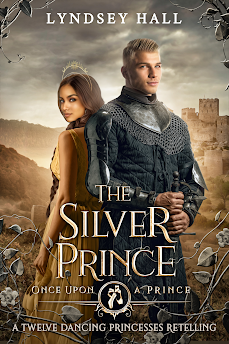
As a "Silver" soldier who just fought in a war, the last thing Prince Anders wants is to be noticed in the kingdom of his enemy. However, he finds it hard to resist the temptation to watch a performance of his favorite ballet and decides to sneak away for a night on the town. To his horror, he is caught up in the most incriminating position imaginable when the prima ballerina, who happens to be the kingdom's beloved crown princess, falls off the stage, and he rushes to her rescue in front of the entire audience. For the blatant audacity of this action, he is immediately brought to the dungeon and imprisoned. His only hope at freedom revolves around uncovering the mystery of the princesses' worn-out dancing shoes each night. Though Princess Isadora sees him as an enemy, she must learn to trust him if she has any hope of breaking the curse that forces her and her sister to dance each night.
The first full-length novel adaptation I've read of "The Twelve Dancing Princesses" was Princess of the Midnight Ball by Jessica Day George. As far as I know, this was the first book to conclude that the princesses danced each night against their will and needed a hero to break the curse. Since then, every full-length adaptation that I have read turned the nightly dancing into a curse that needed to be broken, even some of the more creative ones. I've always enjoyed this fairy tale because it was originally about princesses escaping into their own fantasy world, which was accurately portrayed in the Barbie version of the story. This book follows the format of other adaptations, causing the princesses to be damsels in distress as opposed to young women who take control of their own destinies. It also simplifies the number of princesses to two sisters, writing off the less important characters under the nightly trance as other ballerinas from the company and princes who failed to solve the mystery.
The main characters in this story don't quite hit the mark either. The male lead in the original fairy tale was a commoner who was gifted with a magic invisibility cloak, which made for an interesting "rags to riches" dynamic. In this version, he is a prince who already has powers, so there isn't as much for him to gain besides the alliance between the two kingdoms. I like that Isadora is a ballerina in addition to the secret nighttime dances, giving off Find Me in Paris vibes, but the book doesn't expand upon whether she is passionate about ballet or just does it because of her status. The love story comes off as contrived at times. It seems like Isadora doesn't like Anders at first because he is a Silver, and she only decides to get close to him later for the sake of breaking the curse and not because they share any sort of deeper connection.
The Silver Prince by Lyndsey Hall is a decent addition to the Once Upon a Prince series, offering a unique retelling of "The Twelve Dancing Princesses" with an enemies-to-lovers twist. While it didn't quite live up to my expectations, it was an enjoyable read that explored the complexities of trust and alliance-building between rival kingdoms. However, the characters fell a bit flat for me, and the love story felt forced. Despite this, I appreciate the creative liberties taken to reimagine the classic fairy tale and look forward to reading the remaining books in the series. If you're a fan of fairy tale retellings and are interested in a fresh take on "The Twelve Dancing Princesses," The Silver Prince might be worth checking out.July 15, 2024
Review: A Wingless Hope
A Wingless Hope by Sydney Winward is a retelling of "Thumbelina" from the Hope Ever After series, which supports Operation Underground Rescue to help fight against child sex trafficking. This is the fourth book I've read from this series and the second adaptation I've read of "Thumbelina." One reason authors tend to shy away from this story could be that it contains more high fantasy than the average fairy tale, which makes it perfect for Hope Ever After. All the books I've read in this series so far plant additional magic lore into the fabric of the stories they tell, and this book is no exception. Where the original fairy tale was simple and doesn't always make sense, this version creates an entire culture around Thumbelina's race including two different types of pixies to explain why she was born without wings.
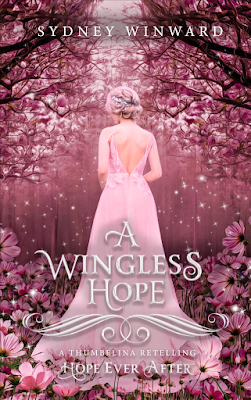
Briar is a lost princess whose flower seed was stolen away by a bird before she was born, causing her to grow up alone in the wild without knowing her true identity. Quinn, her betrothed, injured one of his wings trying to rescue her seed and devotes the rest of his life to finding her and bringing her home. Relations are not well between the Shades and the Flares due to an unknown enemy that seeks to rob both pixie courts of their powers. Where Quinn's life is surrounded by paranoia and political intrigue, Briar spends her days learning to survive in a big world that seems to have no place for her kind. The Shades and Flares have a similar dynamic to the Seelie and Unseelie courts of fae lore. Quinn and Briar's marriage was meant to unite the two races in an alliance. Due to the interfering forces, Briar grows up ignorant of all of this and is overwhelmed and confused when she is discovered by the other pixies later in life.This story does not follow the original fairy tale as closely as the beloved Don Bluth movie. It places more focus on the pixie courts than it does on animal kidnappers, but there are several tasteful references to the film version for readers who enjoyed it during their childhoods. My favorite parallel between the book and the fairy tale is the human mother who finds Briar and takes care of her for a short time. Instead of an old lady, this book introduces an imaginative little girl named Priscilla who likes to build pixie houses and sew doll clothes for stray pixies to try on. When she discovers Briar, she is delighted to invite her into her home and asks her father to let her keep her. Though this behavior could have come off as toxic, Priscilla is given a positive portrayal as a caring girl who is too naive to understand the politics behind Briar's world and the ramifications of keeping her. Her character is perfect for a series meant to support captive children because she represents the innocence and hope of freedom.
The romance in this book is charming, though not ideal. There are many princess stories about finding love in arranged marriages due to the nature of the role. Briar's desire to love someone her own age and species is no different from any other princess story. Since Quinn uses a proxy for himself at their wedding, Briar falls for him before realizing that he is her husband, allowing the two to have a "meet cute" despite their arranged marriage. However, the lack of honesty in their relationship is mildly concerning. Although Briar is insecure about growing up apart from the pixie courts, it's incredible how much she understands in such a short time. I was a little surprised there was no language barrier despite her growing up in the wild, but that is common in fantasy stories like this. In the end, I supported her relationship with Quinn aside from a few rough patches that were quickly ironed out.
A Wingless Hope by Sydney Winward is a charming retelling of "Thumbelina" that brings a fresh perspective to the classic fairy tale. With its richly detailed world-building, engaging characters, and sweet romance, this book is a must-read for fans of fantasy and fairy tale retellings. The author's careful attention to detail and creative additions to the original story make this book a standout in the Hope Ever After series. Moreover, the book's themes of hope, freedom, and the power of innocence make it a fitting contribution to the series' mission to support Operation Underground Rescue and the fight against child sex trafficking. Overall, A Wingless Hope is a delightful and inspiring read that will leave you feeling uplifted and hopeful.
July 14, 2024
Disney's Descendants Makes Even Less Sense Thanks to The Rise of Red!
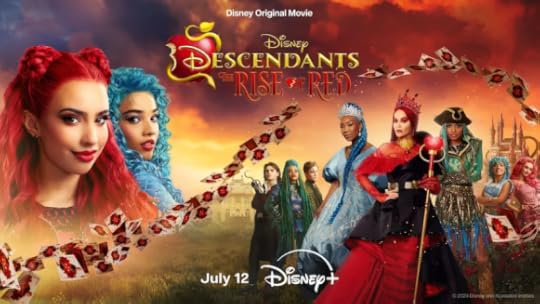
The Rise of Red follows a paper-thin plot in which Lizzie Hearts Red, the daughter of the Queen of Hearts, is upset that her mom isn't supportive enough of her and isn't a very nice person in general. She receives a magic pocketwatch from the Mad Hatter (justifying the working title of this film, The Pocketwatch) that takes her back in time to when her mother attended Auradon Prep under the name Merlin Academy. She is shocked to learn that her mother used to be a kind and optimistic person. Thanks to the film's erratic pacing and sequel bait at the end, it is never revealed why her personality changed so drastically since then. Ashlynn Ella Chloe, the daughter of Cinderella, follows Red into the past to try to save her own mother, who was captured by the Queen of Hearts' playing card soldiers. Why was the time travel necessary? Couldn't they have stayed in the present, put Cinderella on trial, and turned Red and Chloe into her defense team allowing the secrets of their past to come out on the witness stand? Something similar was done in Once Upon a Crime , a Japanese movie that came out on Netflix last year, which was far more entertaining.
The plot inconsistencies make even less sense when it comes to the fan service casting of Brandy and Paolo Montalban as Cinderella and Prince Charming. These two talented actors portrayed these characters in the 1997 made-for-TV adaptation of Rodgers and Hammerstein's Cinderella. However, it was revealed through flashbacks that they were not playing the same versions of these characters. In The Rise of Red, Ella was a student at Merlin Academy who was an outcast due to her commoner background. If Merlin Academy used to be a school just for royals, it poses the question of why she was able to attend at all. It leads to some interesting revelations when Chloe learns the truth about her mother's past with the song Ella sang to her future daughter about being willing to get her hands dirty being one of the best in the film. However, changing her backstory so much makes little sense in terms of how she came to be Cinderella. To make things even more confusing, Brandy performs a duet with Paolo of "So This is Love" from the animated 1950 version of the film, which also contained a modified version of the events in their film. Disney is throwing everything from the past out the window with their multiverse trend.
Descendants incorporates a particular aesthetic of teenybopper pop stars who dance around in brightly colored wigs and punk leather fashion. Red and Chloe give off fire and ice vibes in this film with their head-to-toe red and blue looks. Although these color schemes provide a striking contrast to watch onscreen, their modern girl-boss personalities are not enough to justify such stark visual symbolism. Moving further along on the note of modern sensibilities, I groaned when Ella told her future daughter that her "princess is showing" in her sequence, a clear reference to the modern colloquialism "Your privilege is showing." Adding fuel to the fire is the horrific music that accompanies the films in this franchise. Heavily synthesized pop music with the autotune turned up to 11 is only the tip of the iceberg when it comes to this film's ear-wrenching soundtrack. There were many times when two characters would be having a conversation and suddenly begin rapping their dialogue for no apparent reason. Not only was it distracting from the plot, but it sounded awful in general.
The Rise of Red is a disappointing addition to the Descendants franchise, with a convoluted plot, inconsistent character development, and a jarring soundtrack. If you're looking for a superior alternative, I highly recommend PattyCake Productions' Villains Lair web series, which offers a more cohesive and engaging take on what happened to the Disney villains after their downfall. With its well-developed characters, clever plot twists, and memorable music, Villains Lair is a must-watch for fans of the genre. Disney's Descendants franchise, on the other hand, seems to be running out of steam, relying on tired tropes and lazy storytelling. It's time to move on from this lackluster franchise and embrace a new standard in villainous storytelling.
July 9, 2024
Slay the Princess Is the Most Confusing Visual Novel You've Never Played!
If you think princesses are meant to be rescued, you might just be the perfect victim hero for Slay the Princess, a horror visual novel available on Steam. Although it's classified as a horror game, the endlessly branching story arcs can be whatever you want them to be. The game a psychological thriller based on player perspectives. If you want the princess to be a damsel in distress, she will be, but if you start second-guessing her integrity based on the slanderous claims of the narrator, she will turn into something just terrifying enough to validate your fears. At the end of the day, this game is a complicated mess of time travel and existential symbolism where nothing is what it seems. No matter how confused you are while playing, it's impossible not to appreciate the ever-expanding number of routes that are available as well as the detailed pencil drawings, multi-faceted voice acting, and haunting score.
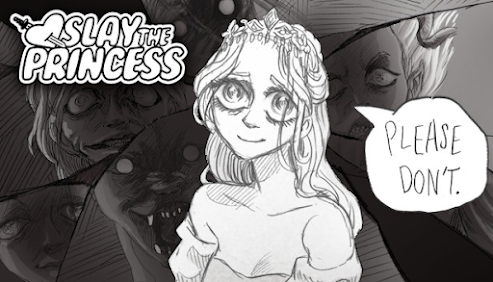
Every chapter starts the same way. You're on a path in the woods. At the end of that path is a cabin. In that cabin is a princess. You must slay the princess. If you don't, it will be the end of the world. After several playthroughs, you will get sick of hearing those words. The game puts players on an endless time loop in which no matter what choices they make, they continue to return to the same cabin again and again. However, the cabin is not the same every time, and neither is the princess. Both will shift based on your decisions on whether to rescue her, attack her, or find a middle ground. If you are kind to her, she will become gentle in turn, and if you are cruel, she will become a monster from beyond your worst nightmares. No matter what happens, she never blames you for any of it because the decision to kill her is not your own but that of a mysterious narrator who keeps trying to drive you to his own ends.
Since nothing in this game is what it seems, you will ultimately discover that the princess is not really a princess, the narrator is not really a narrator, and the hero is not really a hero. Does knowing that change the impact of any of your decisions? Even if she's not a princess, killing her still feels like murder. The time loop must be repeated a certain number of times before being able to unlock a true ending, of which there are several. The game presents a multitude of potential of outcomes, which is a dream come true for visual novel fans who love making new decisions and changing the course of the story. With each decision you make, a new voice enters your head driving you a bit closer to insanity each time. Although there are a number of different voices that can be unlocked, the most entertaining for me is the Voice of the Smitten, who falls head over heels in love with the princess and is absolutely convinced that she can do no wrong and disregards any evidence to the contrary.
Near the end of a full playthrough, you are given the opportunity to ask why the entity you know as the princess is presented in such a way. The answer it gives is pretty interesting. She is a person in a position of vulnerability who is superior to you, but not so superior that the player would feel uncomfortable interacting with her. Making her a princess also gives us pause before trying to harm her because it feels so wrong, allowing players an opportunity to question the narrator and his motivations. The different voices that enter the player's head have different reactions to her as well, and each of her personas is accompanied by a haunting pencil drawing that is both lifelike and unnervingly still. It is only by completing a playthrough involving many loops of the same scenario that we can learn the true purpose of the game and choose an outcome with a elevated sense of understanding.
Slay the Princess is a thought-provoking and unsettling visual novel that challenges traditional notions of princesses and heroism. With its innovative time loop mechanic, branching routes, and captivating storytelling, this game is a must-play for fans of psychological thrillers and visual novels. As you navigate the blurred lines between reality and illusion, you'll be forced to confront your own biases and question the true nature of the princess and the world around her. Will you slay the princess, or will you uncover the truth behind the mystery? The choice is yours, but be warned: nothing is what it seems, and the truth may be more terrifying than you ever imagined.July 8, 2024
Review: A Last Hope
The aptly titled A Last Hope is the final book in the Hope Ever After series. I received an ARC from the author, Verity Sandahl to read before its release date on July 17th. This book is a gender-bent retelling of "King Thrushbeard" and contains a unique take on the story in a fantasy setting. Like all the books in this series, proceeds on sales will go toward Operation Underground Railroad to help fight against child sex trafficking and protect children from exploitation. This book has more Christian messaging than the other Hope Ever After books I've read, but it was still enjoyable as someone from a different religious denomination. The story focuses heavily on star-crossed lovers, which is my favorite type of romance.
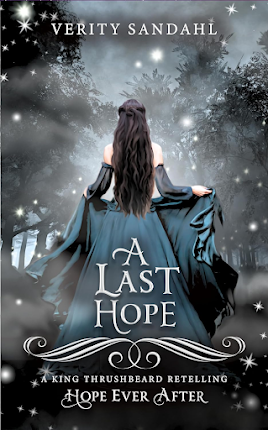
Princess Arianna hails from the Thrush kingdom whose royalty has the ability to fly. Prince Marc, from an enemy kingdom, is an empath, who can read people's emotions by touching them. When the two take an illicit flight as children, they form a deep bond that Arianna begrudgingly recognizes as soulmates. When Marc is unable to rescue her from an attack on her kingdom after their first encounter, she blames him and holds him responsible for the mutual violence and corruption of their monarchies for many years. As an adult, Arianna takes on a new identity as Aria, a peasant tanner, and draws the attention of Marc, who is now king. Though he recognizes her at first, she manages to convince him that she is a different person, but that doesn't stop him from falling in love with her all over again. He is happy to have her at his side even after his brother betrays him and takes away his crown.
This book cleverly weaves in elements of "King Thrushbeard" while telling an original story of the power of forgiveness. I was pleasantly surprised to find that it was gender-bent because that is something I rarely see from this fairy tale. Allowing the male character to learn humility instead of a spoiled princess gives the story a new sense of perspective. Yet, the princess in this tale has an important lesson to learn as well, putting both characters on equal ground. The depth of Arianna's character is fascinating. On the outside, she hates Marc and blames him for everything that happened to her family, but deep down, she craves his love and secretly cares for him the same way he does for her. Ultimately, both characters would need to open their hearts to each other to save their kingdoms.
Although the romance between Arianna and Marc was the heart of this book, it also has a great supporting cast. Marc's brother, Thomis, is a calculating yet supportive prince with an agenda of his own and a secret ability that is revealed much later. Arianna's friend, Casimir, a rebel captive, motivates her to get close to Marc so she can rescue him. He is the leader of the rebellion to take back her kingdom, and many of her decisions throughout the book revolve around her desire to help him. When Marc learns of his alliance with Casimir, it causes him to question their marriage. It is his undying faith in her that saves everyone in the end.
A Last Hope by Verity Sandahl is a thrilling gender-bent adaptation of "King Thrushbeard" that masterfully weaves elements of forgiveness, humility, and love. With its unique fantasy setting, complex characters, and original storyline, this book is a must-read for fans of fairy tale retellings. The depth of the characters and the power of their love make this story unforgettable. I'm so glad I got to read this book, and I'm sure you will be too. Don't miss out on this thrilling conclusion to the Hope Ever After series, and remember that proceeds from this book will support a great cause - fighting against child sex trafficking and protecting children from exploitation.July 7, 2024
Review: The Beauty and the Griffin
The Beauty and the Griffin by JM Stengl is the thrilling conclusion to the Faraway Castle series that I started reading during the first year of my blog. It's been a long wait for this sixth installment, but it was worth it. The ARC I received serves as a cathartic conclusion to the stories of all these royal modern-day teenagers who stayed at the enchanted Faraway Castle resort as an escape from day-to-day life. This book is a retelling of "Beauty and the Beast" that adapts the fairy tale uniquely, incorporating elements that are rarely used in other adaptations including the beast's nightly proposals and the beauty's dreams of him as a prince. It is firmly ingrained in the setting of Faraway Castle and contains all of the magical properties of this world that have been set up in the other books. I would not recommend starting the series with this one, but it is well worth diving into these six novels and two novellas from the beginning with Ellie and the Prince.
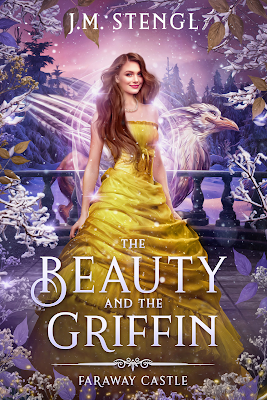
Beatrice, a young nanny, is a humble girl living an ordinary life except when it comes to her occasional trips to the magical Faraway Castle resort with her Auntie Bella. On her first trip, she meets a boy who is friends with a lake monster and spends hours exploring the enchanted creatures and gardens that surround the far-off land. Years later, she returns and befriends the Gamekeeper, a mysterious faceless entity that she knows only as a disembodied voice that is filled with kindness. She has little time to distract herself with him, however, when she is tasked with being a caretaker to the rambunctious Princess Eddi, whose story was revealed in the previous book, The Mirror and the Curse . When Beatrice is finally free of Eddi's mischief, she has the misfortune of crossing paths with Win, another troublemaker who is on a dangerous quest to escort two legendary griffin eggs to safety.
One of the things that surprised me the most about The Beauty and the Griffin is that it started with the main character at only seven years old. I was a little baffled about how it could be a love story if she was only a child, but she grows up quickly, and the book has a long-lasting romance that defies the laws of space and time with many jumps between the past and present. Something else that makes this adaptation unique is that instead of switching perspectives between the two love interests, it is told from the points of view of Beatrice and her Fairy Godmother "aunt," Arabella. Arabella takes on the role of the Enchantress in this story, allowing readers to understand the story from varying angles. Although it was interesting to learn the Enchantress's perspective, I would have liked to see more of the Gamekeeper's thoughts since he was shrouded in mystery for most of the book even though his story is the most intricate and complex of all.
There is a lot that happens in this book, but it is written in a way that is easy to follow. It gets a little confusing at times, especially when it comes to the time travel aspect, but the beautiful fairy tale romance holds it all together and keeps the pages turning. I particularly enjoyed the dream sequences in which Beatrice is reunited with Prince Niel and shares an impossible love with him that seemed too good to be true, but she decided to indulge herself in it because she thinks it's just a dream. After all, it's the perfect escape for someone stuck watching over bratty kids all day! The griffins are another wonderful addition to the story, though the title is a bit misleading because they are not the love interests. Instead, they are two magical babies who bond with Beatrice and speak to her telepathically. Not only are they adorable, but they are determined to help everyone get their happy ending no matter what it takes.
The Beauty and the Griffin is a compelling and unique retelling of "Beauty and the Beast" that masterfully wraps up the Faraway Castle series. With its intricate storyline, lovable characters, and enchanting fairy tale elements, this book is a must-read for fans of the series. Although the official release date has yet to be announced, I highly recommend diving into the world of Faraway Castle from the beginning to experience the magic and wonder that JM Stengl has created. Some of my favorite books from this series include The Rose and the Briar and The Siren and the Scholar . Read some of these earlier books to prepare to be swept away by this thrilling conclusion, and get ready to fall in love with the enchanting characters and their stories.July 4, 2024
Deconstructing the Wicked Stepmother
It was common in the early days of fairy tales for the enemy of a princess or future princess to be her vain stepmother. There were many reasons for this, most of which are no longer relevant by modern standards, causing that trope to fall by the wayside. One outdated reason is that girls rarely left the house (or "tower" if you will) in the old days because they were expected to do housework and eventually become mothers. Therefore, meeting an enemy outside of their own homes would have been unlikely. Why do you think so many princesses long for freedom? The other reason is that fairy tales are meant to encourage children to love and obey their parents, so it would be counterintuitive for them to go up against their biological caretakers. There are a few rare exceptions, but these disturbing stories about horrible parents never made it into the mainstream media for good reason. Giving them stepparents who were brought into their lives at a later time solves this problem and allows the heroine to have a challenge to overcome.
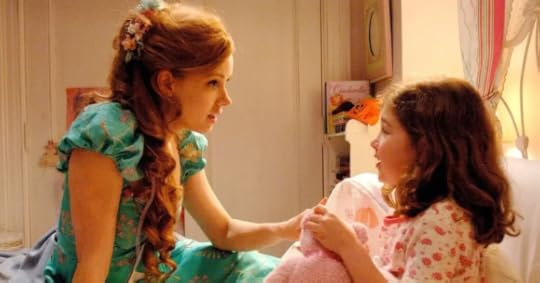
The first time that Disney openly challenged these standards was in 2007 with Enchanted . Enchanted was meant to be a turning point in Disney's history in which they were ready to admit that they had overcome many of the questionable stereotypes of the stories they had adapted in the past and were moving on to healthier standards for the portrayals of girls and women in the media. Indeed, the princess stories that were adapted following Enchanted, including The Princess and the Frog , Tangled , and Frozen , made much bolder changes to their source material than anything they had done in the past. Although their first two princess movie adaptations, Snow White and the Seven Dwarfs in 1937 and Cinderella in 1950 included evil stepmothers as villains, Disney has moved on to portray healthier family dynamics in all sorts of unique situations.
In Enchanted, Giselle, a stereotypical princess archetype, becomes a stepmother to Morgan, the daughter of a single father who is struggling to be a good role model. In a key moment of the film, Giselle tells Morgan that it isn't true what they say about evil stepmothers and that Prince Edward has one who is probably lovely. Although Queen Narissa turns out to be the wicked stepmother of nightmares, her defeat represents a new era for modern media in which nice stepmothers can coexist with more realistic portrayals of modern families. The movie Godmothered, a spiritual sequel to Enchanted from 2020, took this a step further by showing that a single parent can be happy with just the love of her child without even needing to remarry. In 2022's Disenchanted, the actual sequel to Enchanted, Giselle falls under a curse in which she becomes the evil stepmother she has sworn to never be. This enforces that the negative stereotypes of the past can be harmful and need to be overcome for a healthier future.
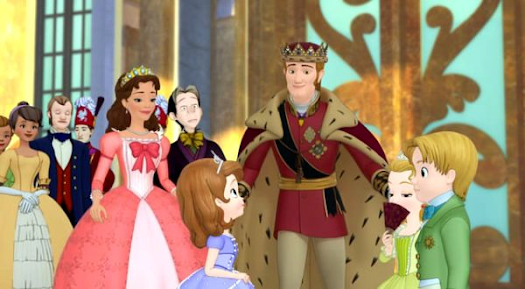
There are many other positive resources available in book format, the new dominant medium for princess stories, including Tales of Virtuous Stepmothers, an anthology of original fairy tales by Georgina Warren, and My Fairy Stepmother, a picture book by Marni Prince. These resources are great for children who are struggling with major changes in their family and still want to feel like the heroine of a fairy tale. Change doesn't have to be a bad thing, and Fairy Godmothers can come from the most unexpected of places. At the end of the day, being a true princess is all about embracing love and kindness, and that includes people who might enter their families unexpectedly. My favorite series, Sofia the First, centers around a family formed by new beginnings. Sofia becomes a princess and gains a stepfather, stepbrother, and stepsister, and Amber and James gain a new stepsister in Sofia and a new stepmother in Queen Miranda. The premiere movie, Once Upon a Princess, places a heavy focus on how being a family means more than just sharing the same blood.
The trope of the evil stepmother has been a relic of outdated societal norms, but these standards have been changed and overcome since the turn of the millennium. By portraying healthier family dynamics and diverse representations of love and kindness, modern media has evolved to showcase the true meaning of being a princess. With resources like Enchanted, Tales of Virtuous Stepmothers, and Sofia the First, children can find inspiration in stories that celebrate the beauty of blended families and second beginnings. As we continue to strive for a more inclusive and compassionate world, let's embrace the kindness, love, and acceptance that define what it means to be a true princess.June 30, 2024
Review: The Rose Gate
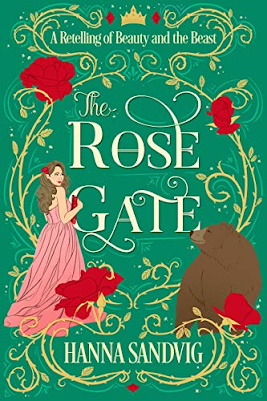
Isobel is a typical modern girl who spends her days teaching kids feminism at the library for a mysterious boss who is more than she appears. Sick of her family's drama, Isobel runs away into the woods one night without considering the danger of getting attacked by wolves in the dark. When the inevitable attack happens, she is rescued by a bear and wakes up on the other side of a faerie portal in an enchanted castle. In the fae realm, the bear becomes a human prince named Leith, and Isobel learns that he is under some sort of curse but finds it difficult to get the enchanted animals living there to tell her more information about it. She tries her best to enjoy her stay, taking advantage of the castle's generous library, delicious food, and beautiful clothing. She befriends the staff, who are also trapped in the bodies of animals, and does her best to get to know Leith better before it's time to return to her world. After a visit back home, she realizes that there are more ties between the two realms than she could have possibly imagined.
I like that this book has a modern heroine from the real world because it makes it easy to follow and relate to Isobel. However, books that do this tend to fall into the trap of characters knowing things they shouldn't because their story already exists in the real world. Despite all of the obvious references to "Beauty and the Beast," Isobel never compares Belle's story to her own. However, there is one awkward part in which she reads the kids a book that contains the "Disney version" of "The Frog Prince" in which a simple kiss breaks the frog's cruse book and deliberates on whether or not that would solve Leith's problem as well. This is an odd choice because the Disney version of "The Frog Prince" isn't even called "The Frog Prince," and when Tiana kisses the prince for the first time, she turns into a frog herself, which doesn't solve anyone's problems. If she had referenced just about any other Disney Princess story, this discrepancy wouldn't exist. I'm not sure if that means these books take place in a world with an alternate version of Disney or if the author isn't familiar with their adaptations.
The Rose Gate introduces a compelling love story and takes the time to develop Isobel and Leith's feelings for each other, even if they include a few misunderstandings along the way. Isobel's lack of experience with romance is cute, and I enjoyed the scene where she asks her sisters to give her a makeover to prepare for a romantic evening with Leith. It was a nice throwback to the nostalgic romcoms from the early 2000s that have become obsolete by modern standards. It is admirable how hard Isobel was willing to work to break a curse on someone she had just met, and I enjoyed getting to know the other inhabitants in the castle. They are just as charming as Cogsworth, Lumiere, and Mrs. Potts, but have their own unique personalities that are separate from the Disney sidekicks. It's always thrilling to read a book that takes place in a world so similar to our own and slowly reveals that there is magic hidden in it, allowing us to imagine how easy it would be for our everyday lives to become magical if we just know where to look.
The Rose Gate by Hanna Sandvig is an enchanting retelling of "Beauty and the Beast" that skillfully blends modern-day isekai elements with the classic tale's essence and fae mythology. Isobel's relatable character and her journey from the real world to Tir Na nOg make for an engaging read. The book's unique take on the classic tale, combined with its well-developed characters, enchanting setting, and sweet romance, make it a must-read for fans of fairy tale retellings. While there may be some minor missteps, the book's charm and magic shine through, leaving readers eager to explore more of the Faerie Tale Romances series and the enchanting world Sandvig has created.
June 27, 2024
Ariel Makes a Splash on Disney Jr.!
The newest incarnation of Ariel made her way to Disney Jr. (formerly spelled Disney Junior) today with more episodes anticipated for Disney+ tomorrow. There were two 23-minute episodes split into four 11-minute long segments today. These continue the worldbuilding of this new version of Atlantic that was first introduced in the "Mermaid Tales" shorts from earlier this month. There was a lot of anticipation for this show, but it also gave pause to fans of the original series from 1991 due to its rewriting of Ariel's past. Although there were many changes made to the appearances, world, and backstories of the characters, many things still remain the same, including Ariel's obsession with human objects and the appearances and personalities of Flounder and Sebastian. Overall, it is a mixed bag that blends the original lore with new changes that are indicative of a different story that may have worked better as a spinoff.
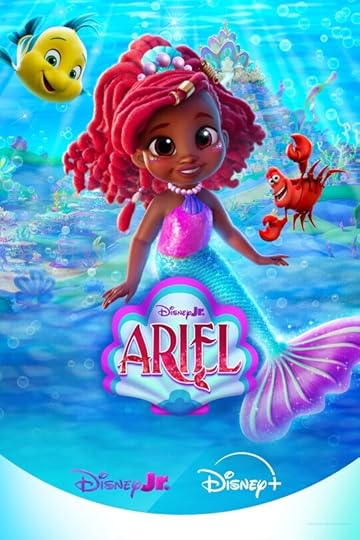
Ariel follows the adventures of a young version of the famous redheaded mermaid in a re-imagined version of Atlantica that resides in the Caribbean. In line with this new incarnation, Ariel and her family have been race-bent and given new personalities. Although Ariel retains her loyalty to her friends and love of life, she is more emotionally stable within her community and no longer comes off as an outcast who would eventually leave everything behind to explore life on land. King Triton is a gentle and loving father who is laid-back and accepting of most decisions his daughters make and would never break their things to prove a point. "Tantie" Ursula is Ariel's beloved aunt who has a close relationship with her and her friends. She is prominently featured teaching them how to use magic in the episode "Ursula's Magic Camp." Her teacher/student dynamic with Ariel is very similar to that of Sofia and Cedric from the beloved series, Sofia the First. Like Sofia's show, each 11-minute segment of Ariel includes an original song inspired by Caribbean beats.
While I think this show would have worked better as a spinoff of Ariel's series from the '90s rather than a replacement, it includes tons of Easter eggs for fans of the original. In the first episode, "Atlantica Day," Ariel finds a fork and decides to name it a "dinglehopper" in reference to the original movie. The rest of the episode focuses on Ariel planning a song for Sebastian about what makes Atlantica special, but no one she asks about it can agree on just one thing. In the end, she realizes that their differences are what make Atlantica so unique and decides to sing about how colorful and diverse it is. This song can be interpreted as a modern throwback to "In Harmony," the famous anti-prejudice song from the original series. Her sisters, Ayanna and Alanna, were not heavily featured in either of these episodes, but were portrayed in the shorts as having similar personalities to the original six sisters, one of whom they are named after and give Ariel a makeover at one point with a pink dress that resembles the one she wore in the original movie.
Ariel has some impressively dynamic writing for a Pre-K. Based on its original description, I was expecting it to be more formulaic like "Doc McStuffins" and follow a routine of Ariel finding a new human object and learning about it in each segment. Instead, the episodes are driven by simple problems that would be relatable to its Pre-K target audience, and the solutions reveal a little something about each character and allows them to learn and grow. Fernie and Lucia are great original additions to the show that represent different personality types. The episode "Fernie's Notebook" focuses on how Fernie is so attached to his notebook that he isn't aware of how much knowledge he can recall without it, which is a great lesson for young kids with security blankets or plushies. "Ursula's Magic Camp" gives Lucia a chance to to try to control her magic and not let it all out before she's ready, which is good for kids who have trouble using art supplies and other things in moderation.
The new Disney Jr. series, Ariel, offers a fresh take on the beloved mermaid's adventures while maintaining some of the charm of the original "sea-ries." With its vibrant animation, catchy Caribbean-inspired songs, and relatable storylines, this show is sure to delight its young audience. While it may not be a direct continuation of the 1991 series, it honors its spirit with Easter eggs and themes that will resonate with fans of all ages. With its dynamic writing, lovable characters, and valuable lessons, Ariel is a great addition to the Disney Junior lineup and her stories from both the past and present are a great watch for any young fan of the little mermaid.
June 23, 2024
Review: The Midnight Prince
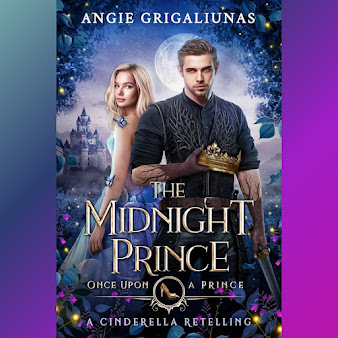
Kirran is a troubled fae prince with a lot on his plate. Not only did his brothers die in a war, making him the next heir to the throne, but he still hasn't gotten over the heartbreak of being abandoned by his childhood sweetheart, Alia. When his father pressures him into finding a bride to sire an heir, he is shocked to find Alia in disguise at the ball. After seven years, he decides to confront her only to learn that she has completely different memories of what happened the night that both their hearts were broken. Fueled by anger over the time that was lost to them, the two lovers go into full detective mode to determine who had the power to change their memories and which person's recollections were correct. They also take the opportunity to rekindle their old passion, despite the king's protests due to Alia being half-human and a servant.
This is such an easy book to dive into. The love story is presented with care and sincerity, and the magic system is easy to follow. Although it takes place in a fae world, the emotions in the book are very human, making the characters easy to relate to. As soon as I learned that Alia and Kirran's relationship was manipulated, I became just as determined as them to solve the mystery. The book moves at just the right pace for a detective story, patiently unveiling clues leading up to a thrilling climax. The magical manipulation of memories is a unique and original twist on the "Cinderella" trope that cleverly incorporates the theme of searching for a lost princess in a new and creative way. I like that the book focuses more on emotion than magic because it makes the story easy to relate to and doesn't require the reader to learn about a complex new world to understand what's going on.
Some "Cinderella" retellings lack a good conflict, but this is not one of them. Kirran and Alia have enemies hidden in plain sight who are determined to tear them apart, and they must find them before it's too late. The book's thrilling climax does not disappoint with a daring rescue and a race against time. The book doesn't swerve too far from the antagonists of the original fairy tale, but it incorporates them in a new way that I have never seen before in a "Cinderella" retelling. Alia's stepmother is surprisingly cooperative and doesn't come off as a heartless abuser, though is still far from perfect. I particularly enjoyed how Kirran was able to use his status as crown prince against his father by referring to anyone who wanted to harm Alia as treasonous due to her being his chosen bride.
The Midnight Prince by Angie Grigaliunas is an intriguing retelling of "Cinderella" that shines with its unique twist on memory manipulation, relatable characters, and a thrilling mystery to solve. Kirran and Alia's love story is expertly woven with fae magic, making this book a must-read for fans of fairy tale retellings. With its perfect pace, lovable characters, and creative conflict, The Midnight Prince is a standout in the Once Upon a Prince series. I can't wait to dive into the rest of the series and see what other enchanting retellings these authors have in store for us. If you'd like to join me, make sure to take advantage of the sale on this series before it's too late!



